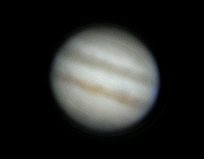AutoStar & StarLock calibrations;
DSLR imaging: Jupiter & Bode's Galaxy
Posted: 28 March 2016
|
Open: Sunday, 27 March 2016, 1800 MST Temperature: 89°F |
Session: 943 Conditions: Mostly clear |
Used the wired AutoStar II this session in order to test a new beta of ScopeBoss via Wi-Fi.
Decided I would redo the TRAIN DRIVES. I had last done it the first night with the 12" LX600, but that was a rough TRAIN DRIVES due to the object selected (low and very distant terrestrial object that was wavering). I still used a distant terrestrial object this night but it was stable. I also used a reticle eyepiece. Set the Mount type to Alt/Az and Targets to Terrestrial. TRAIN DRIVES successful. Unfortunately, switching to Alt/Az from Polar wiped out my AutoStar polar alignment. That would require some bright stars to redo. 1829 MST: powered off the LX600 until stars were visible. That then wiped out the RA PEC training, so it would have to be redone (which would take over an hour for three passes).
1858 MST: powered on the LX600 and did a One Star alignment. 1906 MST: alignment completed. StarLock OFF. GOTO Jupiter placed it just outside the field-of-view (FOV) at 102X. Once centered, the four Galilean Moons were visible, as was the Great Red Spot. GOTO Regulus and SYNCed the AutoStar. GOTO M42; not quite centered. Centered and SYNCed on M42. GOTO Procyon; SYNCed. GOTO M42; still not quite centered. Decided I would redo the polar alignment once the RA PEC training was completed. But the good news was that the minor rubberbanding I had been seeing with the original TRAIN DRIVES had now been eliminated.
1915 MST: powered on the GC Wi-Fi Adapter and began tests of the iOS app ScopeBoss using my iPhone 6s Plus. All tests of the new beta version were successful. 1939 MST: ended ScopeBoss tests; powered off the Wi-Fi adapter.
1945 MST: GOTO Regulus. Then erased RA PEC data (just to be safe). Turned StarLock ON. Did the initial StarLock automated RA PEC training using Regulus. Did the first and second PEC updates using Denebola. 2111 MST: RA PEC training completed. While I was waiting for the PEC training to complete I prepped the D7200 DSLR for prime focus imaging.
With the RA PEC training completed I redid the One Star polar alignment. StarLock OFF. GOTO Denebola and SYNCed the AutoStar. GOTO Jupiter; centered. The Great Red Spot was no longer visible. Then returned to Denebola, which would be the focus test object.
Mounted the D7200 DSLR at prime focus + Televue 2X PowerMate and did a focus test with the Astrozap mask. Then did some HD video recordings, 1.3X crop factor, 60 fps, of Jupiter using various exposure settings. This is a stack of 1305 frames, 1/160sec, ISO 1250, White Balance Auto:

2145 MST: ended Jupiter imaging. Removed the PowerMate and camera. GOTO Procyon and did a StarLock Automatic Guiding Rate Calibration (ARC). That set the RA Guiding Rate to 28% and the DEC Guiding Rate to 18%. Both seemed low, possibly due to poor seeing?
GOTO M81 (Bode's Galaxy); it was placed in the 102X FOV. GOTO Arcturus, mounted the DSLR at prime focus, and did a focus test using the mask.
GOTO M81 and did some framing test exposures, 30 seconds, ISO 6400. With M81 reasonable framed did 2 and 5 minute StarLock guided exposures, ISO 6400, White Balance 4000K. This is the 5 minute exposure, slightly cropped:

I would say that the new TRAIN DRIVES, RA PEC training, and ARC worked pretty well.
2226 MST: eastern sky brightening due to rising waning gibbous Moon. Ended imaging and began closing up for the night.
|
Close: Sunday, 27 March 2016, 2246 MST Temperature: 57°F |
Session Length: 4h 46m Conditions: Clear |
Comments are welcome using Email. Twitter users can use the button below to tweet this report to your followers. Thanks.
Cassiopeia Observatory Home Page
Copyright ©2016 Michael L. Weasner / mweasner@me.com
URL = http://www.weasner.com/co/Reports/2016/03/28/index.html
